 Fatal Attack
Fatal Attack  Injuries
InjuriesFear of the ocean and fear of a deadly shark attack is pretty common. But what really are the odds of a shark attack on surfers? Well, we’ve put together a map of shark attacks all over the world.
If you ever watched Jaws as a kid and had that infamous ominous riff psychologically planted into your brain, it’s not surprising that you might have thoughts about what unknown dangers lurk beneath the surface of the water.
The predatory, haunting score was composed by John Williams who noted ‘It had the effect of grinding away, coming at you, just as a shark would do, instinctual, relentless, unstoppable.’. Enough to scar any kid for life!
With all the media hysteria surrounding the oceans apex predator it’s easy to demonise sharks without really understanding why shark attacks occur. Our aim with this article is to help shed a little more light on these fascinating creatures and dispel the myth that you’re likely to be eaten by a shark.
SHARK ATTACK MAP 2018 – 2019
We’ve put together a shark attack map for 2018 – 2019 (so far) using the data from Global Shark Attack File (GSAF) produced by the Shark Research Institute. If you click upon the icons on the map you’ll find more information about each shark attack, such as what type of attack, type of shark, who was attacked etc. If an icon is set to and area inland rather than a coastal location it is likely that the incidents location can not be found.
Please note: We’ve mapped the data as best as we can but if you notice discrepancies with the data, do let us know.
SHARK ATTACK STATISTICS
The question that many people would like to know the answer to is, just how likely is it that you’d be eaten by a shark and how many shark attacks on surfers are there? Well, according to the International Shark Attack File of the University of Florida’s Museum of Natural History the chances of death by shark in your lifetime are 1 in 3,748,067. Putting that into perspective, the chances of getting heart disease are 1 in 5, Cancer 1 in 7, Air/space accident 1 in 5,051, and by lightning, 1 in 79,746.
What I was amazed by when looking through the data was the low number of deaths from shark attacks and how many were simply mistaken for a shark or even just an accident, “The shark & man simply collided; neither were injured”. It seems if you actually look at the data and think logically, there’s very little to fear when going into the ocean.
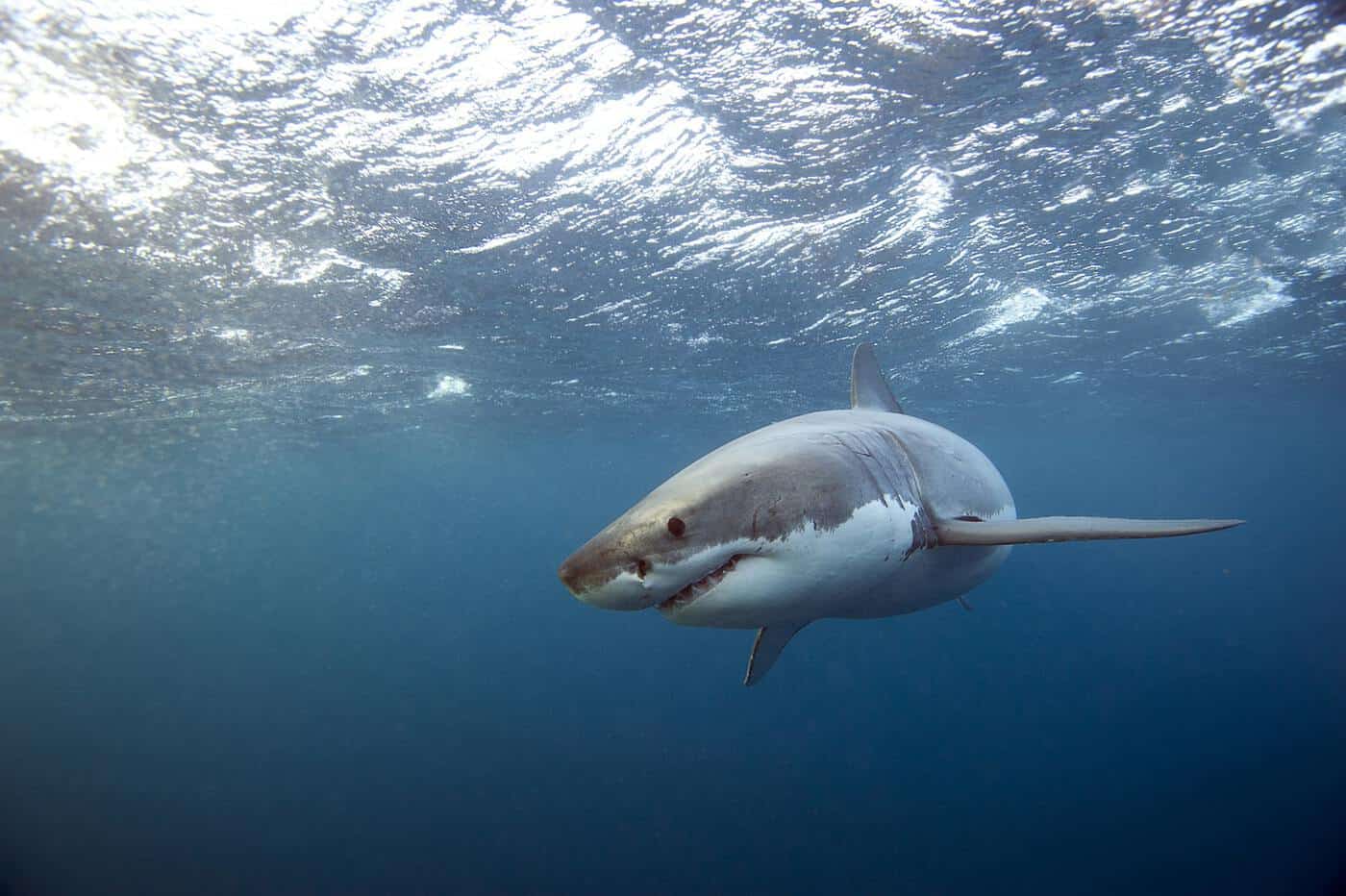
There were 119 incidents of reported human and shark interactions across the world in 2018 and the numbers have fallen since 2017 (138). Out of the total number of incidents in 2018, 88 were unprovoked and 12 provoked.
Of the rest of the 19 cases, 5 were questionable as to whether they were even a shark attack, 9 were invalid cases where the cause wasn’t due to a shark attack such as one case where the injury was thought to be caused by an eel, and 4 involving watercraft, plus 1 that’s still under investigation.
Out of the provoked attacks, 2 cases involved aquariums including someone who put their hand in a shark tank in China and a case where an individual was injured feeding sharks in a Cairns aquarium in Australia.
Out of the invalid incidents one was thought to be most likely caused by barracuda, not a shark and another where there was no injury or attack but considered an “encounter”.
Even just scanning through the various entries on the shark attack map above you soon get the impression that there are fewer unprovoked serious shark attacks than you’d imagine.
NUMBER OF FATAL SHARK ATTACKS
The truth is that fatal shark attacks are very rare, with only 6 fatal attacks worldwide in 2018 and 2 so far in 2019 (as of end of May) according to the GSAF. The media hysteria surrounding sharks plays on people’s fears of predators that lie under the surface of the sea. This contributes to a deep misunderstanding of a creature that is critical to the ecosystem of the ocean.
COUNTRIES AND ACTIVITIES WITH THE MOST SHARK ATTACKS
COUNTRIES WITH THE MOST SHARK ATTACKS
Australia and the USA were way out in front of the other countries for unprovoked shark attacks in 2018 with 27 attacks sustaining injuries and 1 fatal attack each according to GSAF data. Of the other countries, Bahamas had 5 unprovoked attacks whilst South Africa had 5. There were fatal attacks Brazil, Egypt, Mexico and Jamaica.
So far in 2019, the USA has had 11 unprovoked shark attacks with Australia having 5. Brazil and Mexico saw 1 unprovoked attack each and have been 2 fatalities in Reunion Island.
ACTIVITIES WITH THE MOST SHARK ATTACKS
Out of the unprovoked fatal attacks in 2018, 2 were swimmers, 1 was snorkeling, 1 was diving, 1 spearfishing and 1 boogie boarder. Although there were no surfers that suffered a fatal attack you can consider boogie boarding pretty much related to surfing as an activity.
There have been two unprovoked fatal shark attacks so far in 2019 both in Reunion Island. The first attack on a 41 old man happened whilst fishing at the mouth of Rivière de l’Est (Reunion Island). He was recovering fish traps when he was attacked by a Tiger Shark. The second, a fatal attack was on a male surfer in the water off the coast of the small fishing town of Saint-Leu.
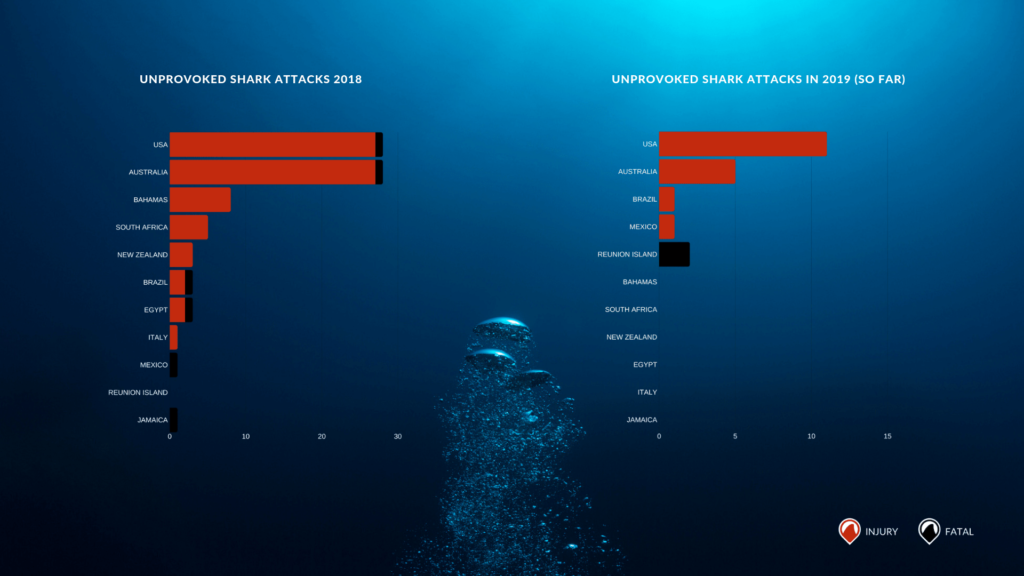
THE HUMAN IMPACT ON SHARK ATTACKS
RECIFE’S SHARK ATTACK PROBLEM
One area that did draw the eye for me when visualising the data on a map was the number of serious or deadly shark attacks in Recife, Brazil. I visited Recife over Christmas and New Year in 2017 and despite what Business Insider reported in 2015, locals do go in the water in Recife… in fact I did. Most locals would go into the water at about waist to shoulder height, despite warning signs on the beach of the dangers of shark attacks.
The locals don’t venture far out, but there was no real sense of danger whilst lounging around on the beach, sipping ice cold beers and snacking on peanuts. But the threat remains, in the year (2018) after my visit a tourist suffered horrific injuries whilst swimming in Recife.
But why Recife, Brazil? Once this area was a surfing hotspot, but you’re unlikely to see many surfers curving up the waves these days as surfing has been banned since 1995 on its urban beaches (Pina, Boa Viagem, Piedade, and Candeias).
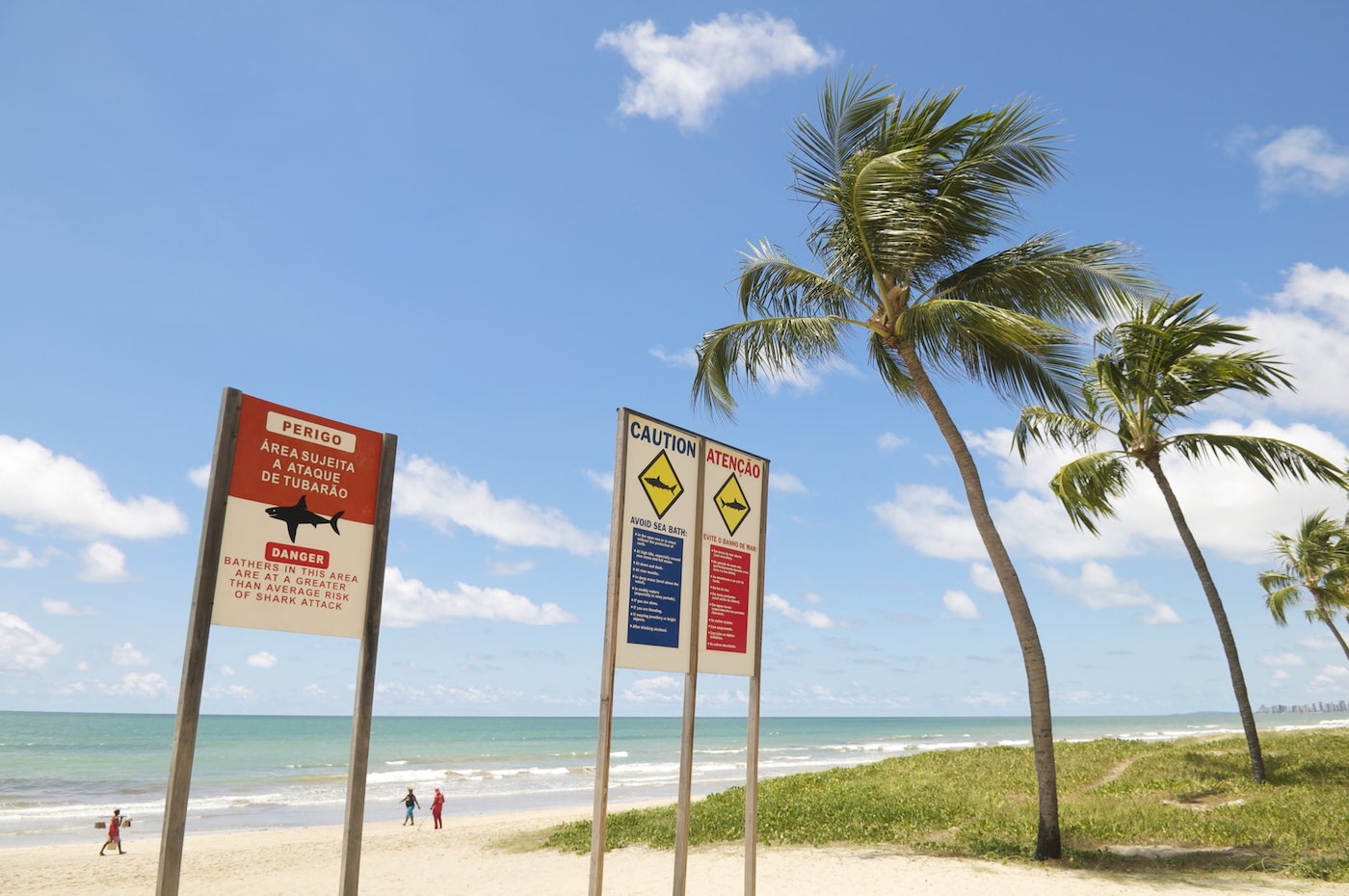
Since 1992 the shark attack statistics have increased in Recife, with many attributing the sharp rise in numbers down to the environmental issues in the area. The nearby estuaries were dredged to make way for docks and the building of a large port, Suape. The increased shipping and disturbance to the environment has had knock on effect for tiger and bull sharks. The bull sharks often swim in freshwater with their breeding lifestyle tied closely to the estuaries. Whilst tiger sharks are attracted by the increased shipping in the area. They are migratory, travel across long distances and are often attracted by debris and rubbish cast overboard.
With almost 2 million inhabitants in and around Recife, the environmental disturbances to the sharks habitat and a deep coastal trench (around 700 metres offshore) running parallel to the city beaches, you can see why Recife is grappling a big shark attack issue.
REUNION SHARK ATTACK CRISIS
Although Reunion had no shark attacks according to the data during 2018, there has been two fatal attacks so far in 2019 (up until May). One on a surfer and the other attack on a fisherman. The shark attack data for this period doesn’t tell the full story of Reunion’s shark attack crisis that began back in 2011.
The island paradise, just south of Mauritius and to the east of Madagascar is blessed with idyllic landscapes, beaches and on the surface, waters. It should be the perfect location for surfers, divers, swimmers and snorkelers but in recent years Reunion has become known for large numbers of shark attacks.
Since 2011 there have been 22 unprovoked shark attacks with 11 of them being fatal. Back in July 2013 the local authorities brought in a ban on swimming, surfing and other water activities along the coastline except in certain defined areas including lagoons or areas where spotters were in place.
A young 13 year old surf champion, Elio Canestri with his seven friends defied the ban in April 2015. He was killed out in the surf when a shark charged him from below. It hit the local and wider surf community extremely hard and led to calls from some, including surfing legend Kelly Slater and Jeremy Flores, who grew up on Reunion, for a cull of Reunion’s sharks.
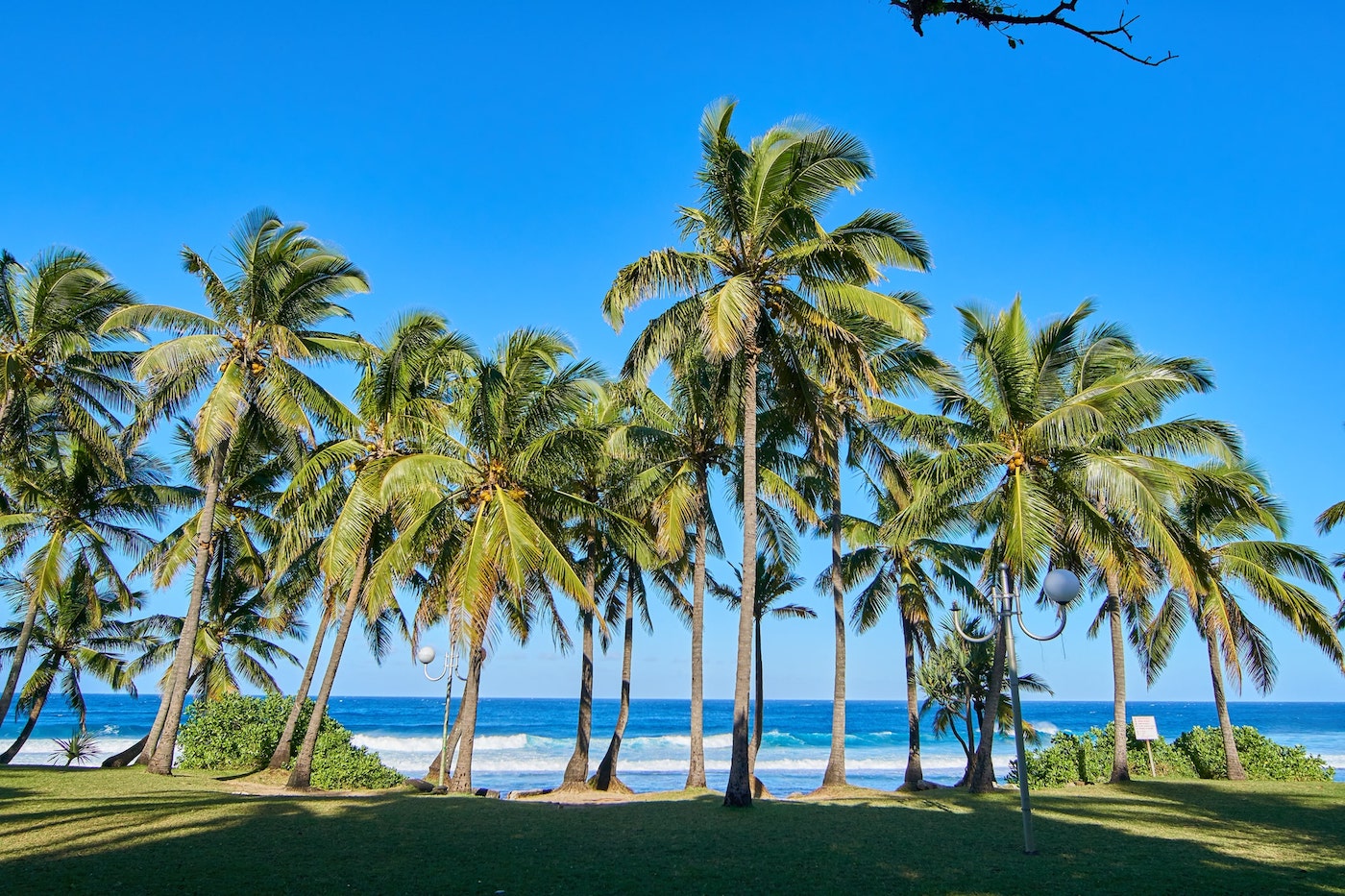
Despite the outcry and call for shark culling, scientists are divided on the cause of Reunions shark problem. It seems there are a number of aspects that have contributed to create an environment where conditions are ideal for the growth of shark populations in the area.
Some locals suggest that bull and tiger shark populations have grown due to a ban on hunting sharks came into force back in 1999. The ban on shark meat was introduced after toxins (ciguatera) that cause nausea and sometime death were identified in shark’s flesh.
However, Reunions shark scenario is far from simple and there are an number of factors that are likely to have contributed to the favourable conditions for these predatory sharks. The islands remote location attracts certain types of sharks, the bull and tiger sharks. These larger species of shark are known to cause serve and often fatal injuries with an attack and could explain why attacks in Reunion often result in death.
Data suggesting that shark attacks began to become a serious issue for the island in 2011 points us towards relatively recent factors. Experts suggest that the urban development and expansion in Reunion causes rain water to run off into the ocean producing muddy waters around the coastline. These waters are perfect for hunting bull sharks. Another theory points towards the deep water and underwater drop offs (not unlike the deep trench that runs parallel with the beaches in Recife) that surround the island that encourage tiger sharks to swim close to the shore in the hunt for food.
The creation of a marine reserve (“Réserve Naturelle”) in 2007 is blamed by many. It was created on the west coast of the island to protect coral reefs but also runs along prime surfing spots. The theory goes that the reserve provides the environment for fish to flourish but the unintended consequence was that it produced the perfect hunting ground for sharks.
Others blame overfishing for wiping out the sharks main food source and forcing them to hunt closer to the shore, or even point to sewage that’s drained into the sea attracting sharks.
Whatever the true cause, it’s likely to be a number of factors and one that was exaggerated by human interference in the sharks natural environment.
SHARK ATTACK PREVENTION REUNION ISLAND
With tourism to Reunion Island plummeting, surf shops and schools closing, the island has begun to fight back in recent years rolling out shark prevention methods and new technology.
In 2015 the government installed anti-shark nets across two of the island’s beaches Boucan Canot and Roches Noires. It was only a year later that the effectiveness of the nets came into question as a 21 year old French tourist lost an arm and his foot as the result of a shark attack at one of the beaches. The surfer had been warned along with others about surfing the stretch of beach when an eight feet hole was found in one of the nets.
Shark-spotting teams have also been used in the waters around Reunion but their effectiveness is often hampered by the poor visibility. The cost associated with using spotting teams also makes it difficult to see it as a viable long term solution.
Drum-lines have also been deployed around the coastlines of Reunion, in an effort to kill many of the large sharks and reduce the risk of being attacked. However many experts believe that the drum-lines bait can inadvertently attract sharks further towards the shore.
Many of the surfers still braving the waters of Reunion wear shark repellent gear such as a leash that emits electrical current. Without a clear solution to Reunion’s shark problem, it seems the only way to truly repel the shark is by staying safely on dry land.
Interesting reading/watching:
Shark Breeding on Reunion Island Deemed to be Cause of Spike in Deadly Attacks
Shark Crisis On Reunion Island: From The Eye Of A Local
Reunion Island surfers will guinea pig shark-prevention!
Surrounded: Island of the Sharks (YouTube)

SHARM EL SHEIKH EGYPT SHARK ATTACKS
Back in 2010 the holiday resort area in Egypt, Sharm El Sheikh suffered a spate of shark attacks that badly injured four tourists and killed one elderly German who was snorkeling. The 70 year old woman was thought to have been attacked by a oceanic whitetip shark, what caused the shark to be swimming so close to the shore was widely debated.
Although the number of attacks in Sharm El Sheikh were dwarfed by the incidents in Recife and Reunion, they all have aspects that point to some degree of human interference in the sharks habitat.
Experts and conservationists points towards a number of theories that led to the shark attacks at Sharm El Sheikh. It’s been suggested that there was illegal feeding and baiting of whitetip sharks in the area by dive schools that disrupted their feeding behaviour. It’s unusual that the whitetip shark attacked closed to the shore but it also at mid-day, potentially suggesting shark had been influenced to expect food at a certain time of the day due to human interference. Others pointed the finger towards glass-bottomed tourist boats trying to attract the sharks to their boats.
Overfishing in the area is another common theory that was put forward after the attacks, leaving the oceanic white tips with a much depleted food source and being forced to search in the swallows.
At the time there was also a theory that a boat importing sheep and cattle from Australia for sacrifice at the Muslim festival of Eid al-Adha could have had an impact on the number of sharks in the area. Some suggested that the animals that had died whilst being shipped had been thrown overboard, causing a large number of sharks to be attracted to the area.
Again, like Reunion Island and Recife, shark attacks appear to have risen as a result of factors linked to human interference in the sharks natural habitat.
THE HUMAN/SHARK INTERFERENCE FACTOR
Locations where there have been a spike in unprovoked shark attacks and fatalities over recent years tend to share factors that are influenced by human activity.
Recife’s shark problem is one case where human environmental impact in the local area with the creation of a river port is likely to have contributed substantially to the areas shark attack problems. Like wise, Reunions shark crisis is also likely to have had an aspect of human interference, whether from creating a natural reserve along the coastline, urban development or the draining of sewage into the sea. Sharm El Sheikh, Egypt also points to evidence of human activity that could have made an impact on the sharks behaviour, with possible shark baiting and dumping of meat into the ocean causing changes in feeding patterns.

CHANCES OF A SHARK ATTACK AS A SURFER
So, for surfers globally, what are the chances of a shark attack? Well, of all the incidents worldwide in 2018, Surfing/board sports made up around 40% of the shark attack results. With swimmers making up 16%, fishing at 9% and spear fishing at 8%, scuba diving at 8%, snorkelers and free divers 4%, scuba divers 4%, wading at 4%, body surfers 3% and simply standing in water at nearly 3%.
Even though surfing and board sports make up around 40% incidents, the statistics need some breakdown to get a better picture of the shark attack odds for surfers.
Surfer.com produced a great article that delved into the data for surfers, taking into account that surfers tend to spend more time in the ocean than the average person. Rather than odds around 1 in 3.7 million they arrived at 1 in 25,641 for lifetime odds of a surfer in the US.
“This new equation sets the lifetime odds of surfer in the U.S. being the victim of a fatal shark attack at 1 in 25,641”
– Surfer.com
MICK FANNING SHARK ATTACK
Surfers all over the world watched in horror as champion surfer Mick Fanning come into close contact with a shark at Jefferys Bay, South Africa during J-Bay Open in 2015. He escaped injury but the tournament was called off.

Incredibly, two years later at the same tournament, Fanning was pulled from the ocean yet again as a three metre long shark was sighted in the water. Although the original incident in 2015 looks (and would have been for Fanning) incredibly frightening, some Great White Shark experts question if it was really an attack.
Andy Casagrande, underwater cinematographer argues that the shark is likely to have come into contact with Fanning’s leash and reacted, thrashing around to get away from being entangled. He’s suggests that “If it was a kill attempt, they come at speed from below and they either go for the head or the tail,” and “When they rocket up from the depths, they’re committed.”.
Casagrande also noted that the timing of the J-Bay Open and the fact that it’s held on Great White Shark hunting around created a conditions for an incident, “It’s like you’re holding a rugby game in the Serengeti National Park during the great migration.”. Knowing this information it’s probably less surprising that Fanning was again pulled from the water two years later at the same competition due to a shark sighting.
THE SHARK UNDER THREAT
Even though shark attacks are worldwide are a rarity, human-shark incidents receive a high level sensationalism from the media. This emotive reporting of provoked and unprovoked shark bite incidents damages the basic understanding of sharks and their behaviour. The terminology used by news outlets tend to demonise sharks in the eyes of the public increasing their fear and trust of these creatures. Bite-back.com is an organisation that aims to educate people and eliminate shops/restaurants from selling shark products, they have an excellent set of guidelines for media outlets when reporting about encounters with sharks.
Often knee jerk reactions to fatal shark attacks leads to a call for a cull of large predatory sharks in the area. Locals will often hunt down sharks hoping that they’ll capture the shark that carried out the attack, in reality a single rogue shark is unlikely to be the only culprit. Research shows that simply killing sharks negatively affects the marine ecosystem.
Although smart drum lines are being tested where sharks are caught tagged and released further off shore, traditional drum lines are still being used as a solution to shark attacks. Even when drum lines are deployed to capture but not kill sharks, a percentage of those caught will die. In Western Australia, Fisheries Minister Dave Kelly said “there is currently no scientific evidence to show that drumlines reduce the risk of a [shark] attack”
Removing the biggest predators in the ocean destabilises the complex ecosystem and is a devastating blow that cascades down the food chain. Sharks keep the ocean’s ecosystem in balance but human activity is increasingly endangering many underwater species.
“in various other systems, it has been demonstrated that predators can
play an important role in structuring communities by controlling prey populations and preventing ecological dominance” – Loss of Large Predatory Sharks from the Mediterranean Sea
LESSENING THE RISK OF SHARK ATTACK
By understanding the sharks behaviour we can make strides to make human and shark interactions even rarer than they currently are. With the implementation of early-warning systems and technology that monitors sharks we can empower surfers and other water users with better information to make decisions that can potentially avoid a dangerous encounter.
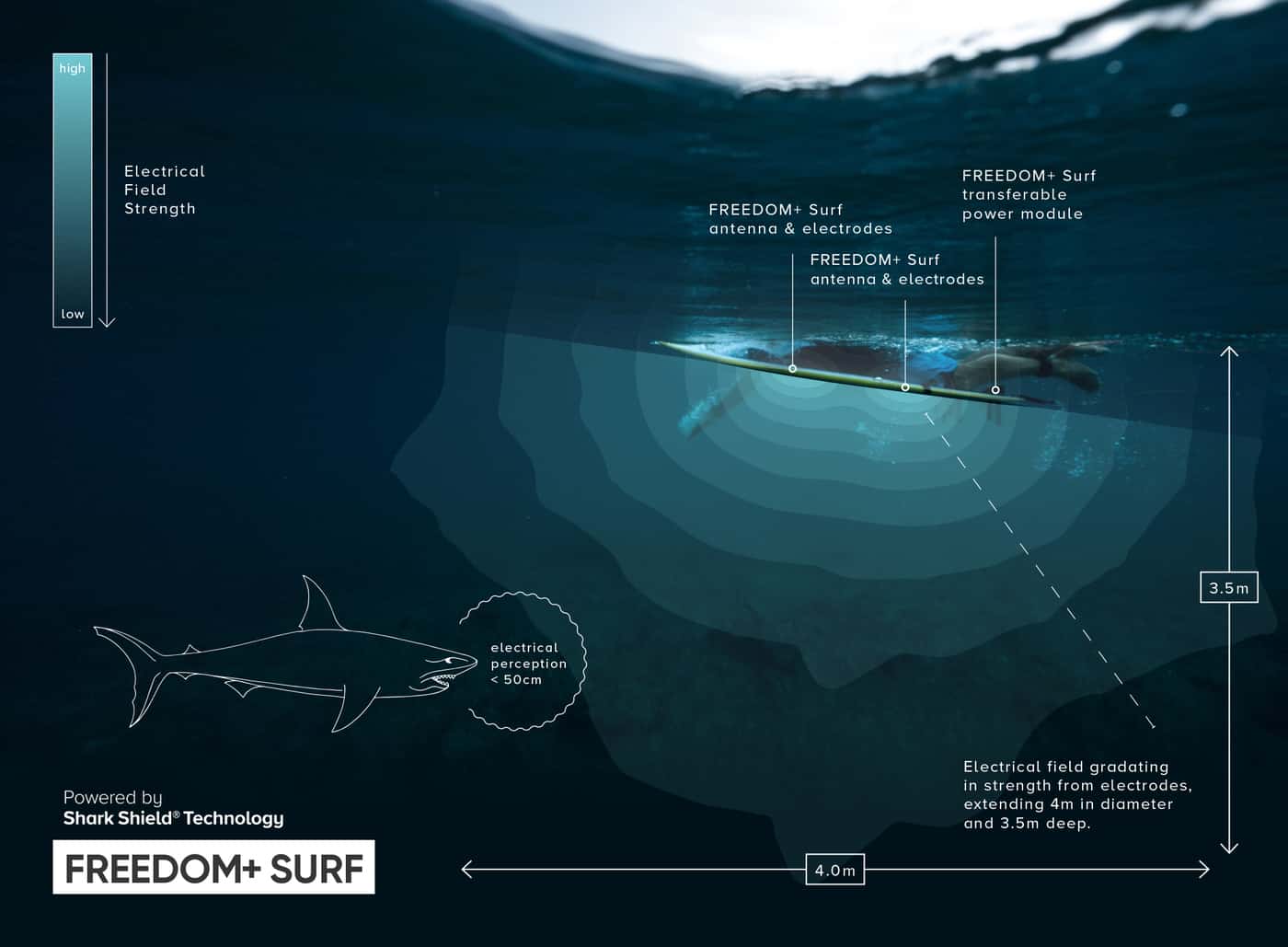
SHARK REPELLENT PRODUCTS
Many surfers in shark attack hotspots are taking matters into their own hands using shark repellent/deterrent technologies. Some of the solutions are backed by credible research, whilst others are more questionable in their ability to repel a shark attack.
Shark Shield
The shark shield produces a three dimensional electronic field around the user with the use of two electrodes. According to the manufacturers if a shark comes within a few meters they experience muscle spasms due to the electronic pulses emitted by the device.
NoShark
Like Shark Shield, NoShark gives out a high voltage proprietary signal that has an affect on the gel in a sharks nose.
SharkBanz
Sharkbanz use powerful magnet that deter sharks when they approach. According to the manufacturer it works because sharks detects the device electromagnetic field which is akin to a bright light suddenly being “shined in your eyes in a dark room”. The device is always on and doesn’t require batteries or charging.
Modom Shark Leash
Modom Shark Leash apply Sharkbanz technology to a surf leash. It creates a field around the surfer that sharks can detect around two metres away. It gives them a unpleasant sensation that gets worse the closer they get. It doesn’t require batteries or need charging at all.
VULNERABILITY OF SHARKS
With the media hype and sensationalism surrounding shark attacks in the media, it’s easy to forget that sharks are actually extremely vulnerable. Sharks as apex predators are critical to the oceans ecosystem as a whole and the human impact on shark populations around the world can not be overstated.
There are many reasons that sharks are vulnerable, here are the main ones:
SHARKS ARE SLOW GROWING
Sharks are slow growing creatures and take a long time to reach maturity. This means many are killed before they even have chance to reproduce. Over fishing is putting shark numbers at threat all over the globe.
SHARKS DON’T PRODUCE MANY OFFSPRING
The number of offspring sharks produce varies from species to species, some having just two and others anywhere from 40 to 80. It might sound a lot but when you compare that to some species of fish that have millions of offspring you can see that sharks populations are vulnerable.
OVERFISHING
It’s estimated that over 100 million sharks are killed a year around the world. It’s a huge number which means many shark populations are struggling to recover. Much of this overfishing comes from illegal shark finning, fuelled by the appetite for shark fin soup. Shark finning is particularly cruel and wasteful as it’s a process where the fin is cut from the shark (which is often still alive) and the body is dumped back into the sea.
There’s also demand for shark cartilage which is often found in health supplements, as well as shark liver oil that’s also found in cosmetics. Shark leather is popular in the United States, northern Europe and Japan where the durable material is made into a whole range of items such as furniture, gloves, belts and watches.
Shark teeth and jaws are often sold in coastal tourist shops all over the world. This is despite it being illegal in many places to even catch sharks.
THE DESTRUCTION OF SHARKS HABITAT
Shark populations rely on healthy oceans around the world but increasingly climate change, pollution and destruction of their natural habitats is having a huge negative impact. The destruction of areas that provide conditions for sharks to breed, shelter and give birth to offspring (such as in the bull sharks in Recife, Brazil) is threatening shark populations. The ecosystem of our oceans need sharks as apex predators at the top of the food chain in order to keep other marine life in balance.
THE OUTLOOK
After studying the data on shark attacks it becomes clear that the chances of an encounter with the oceans most feared predator are pretty slim. An increase in the number of unprovoked shark attacks can be explained by the increase in the number of people spending time in the oceans around the world.
The data shows a pattern of fatal attacks in places where there has been an element of human interference. Looking at Recife, Brazil, Sharm El Sheikh, Egypt and Reunion Island, you can see the effects of changes to the sharks habitat and action that has an impact on the sharks behaviour.
More research and monitoring of the behaviour of sharks is needed to gain a greater understanding of how to prevent attacks and how human action can have harmful side effects for sharks. Despite engaging in testing various preventative measures such as anti-shark nets, shark spotters and drum lines in places such as Reunion Island, unprovoked fatal shark attacks have continued.
Overall globally, as a surfer or anyone who’s taking part in a activity in the ocean it’s still extremely unlikely that you’d ever encounter a shark attack.
SAFEGUARDING THE FUTURE OF SHARKS
If you’ve read this piece hopefully you may feel slightly differently towards sharks. Well if you do, then you might want to take a look at some of the organisations doing amazing work to protect sharks and promote a global healthy marine ecosystem.
The Shark Trust is one such organisation tackling the problems that sharks are facing whilst finding real-world global solutions. For more information and the opportunity to sponsor take a look at The Shark Trust’s website.
As mentioned earlier in the article, Bite-back.com is an organisation that aims to educate people and eliminate shops/restaurants from selling shark products, they have an excellent website too crammed full of information and opportunities to add your support.